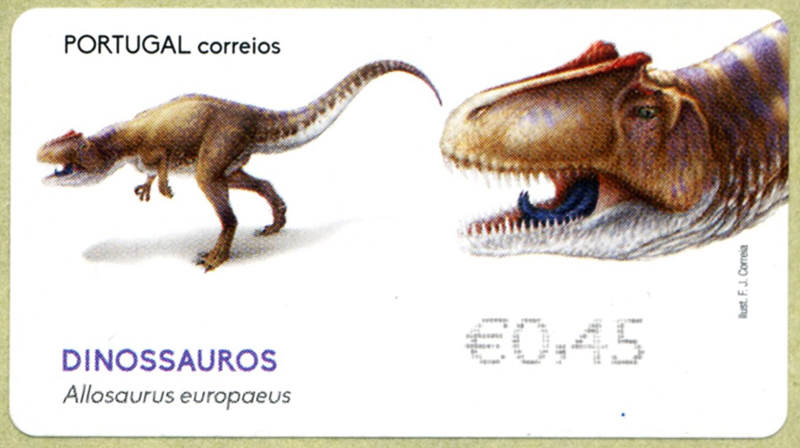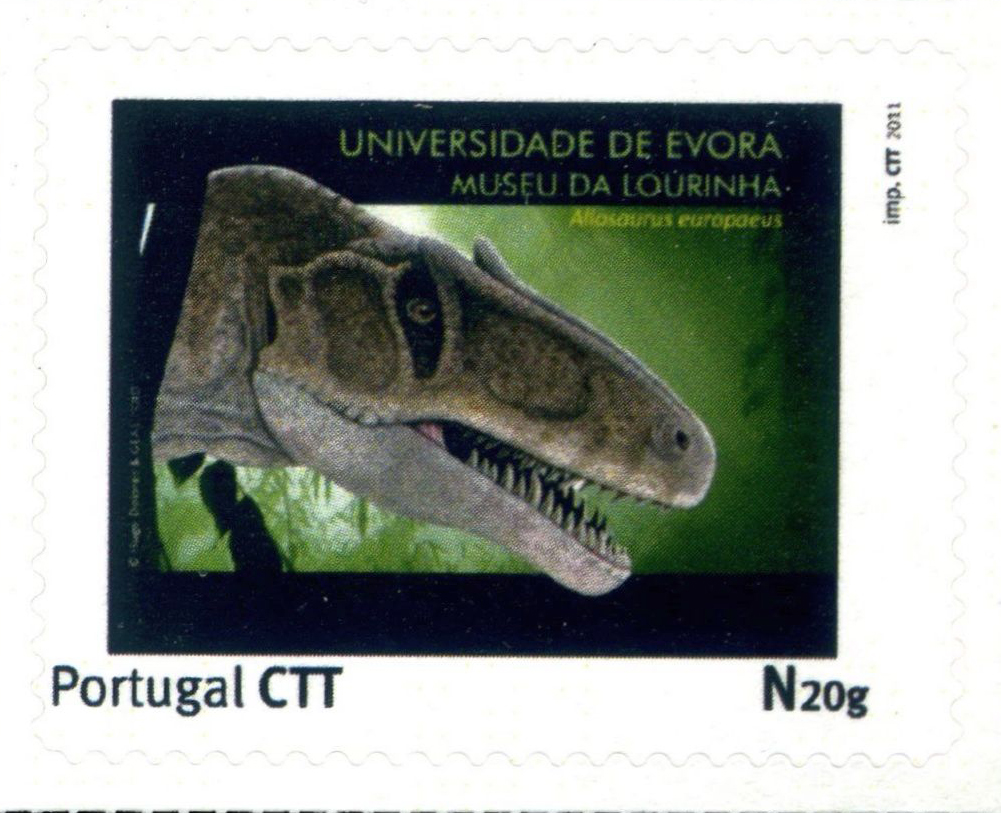Allosaurus europaeus Mateus et al., 2006

Phylum: Chordata Haeckel, 1874
Subphylum: Vertebrata Cuvier, 1812
Classe: Dinosauria Owen, 1841
Ordine: Saurischia Seeley, 1887
Famiglia: Allosauridae Marsh, 1878
Genere: Allosaurus Marsh, 1877
Descrizione
È la seconda specie ascritta al genere di Allosaurus, descritta ufficialmente ad opera di Mateus et al. nel 2006, a partire da del materiale rinvenuto in Portogallo. Tali resti erano stati ritrovati nel 1999 (MHNUL/AND.001), e comprendevano uno scheletro parziale, compreso un osso del quadrato, alcune vertebre, costole, la gastralia, il chevron, una parte dei fianchi e gli arti posteriori. Inizialmente l'esemplare fu descritto come A. fragilis, ma la successiva scoperta di un cranio parziale con il collo annesso (ML 415), ritrovato nei pressi di Lourinhã, datati al Kimmeridgiano, hanno portato i paleontologi a nominare una seconda specie che chiamarono A. europaeus. Si differenzia dalle altre specie di Allosaurus per i particolari dettagli anatomici del cranio.
Diffusione
Visse da 155 a 145 milioni di anni fa durante il tardo Giurassico (dal Kimmeridgiano al tardo Titoniano). Portogallo.
Bibliografia
–John R. Foster, Paleoecological Analysis of the Vertebrate Fauna of the Morrison Formation (Upper Jurassic), Rocky Mountain Region, U.S.A., New Mexico Museum of Natural History and Science Bulletin 23, Albuquerque, New Mexico Museum of Natural History and Science, 2003, p. 37.
–John Foster, Allosaurus fragilis, in Jurassic West: The Dinosaurs of the Morrison Formation and Their World, Bloomington, Indiana, Indiana University Press, 2007, pp. 170-176, ISBN 978-0-253-34870-8.
–Karl T. Bates, Falkingham, Peter L., Breithaupt, Brent H., Hodgetts, David, Sellers, William I. e Manning, Phillip L., How big was 'Big Al'? Quantifying the effect of soft tissue and osteological unknowns on mass predictions for Allosaurus (Dinosauria: Theropoda), in Palaeontologia Electronica, vol. 12, nº 3, 2009, pp. unpaginated. URL consultato il 13 dicembre 2009 (archiviato il 25 dicembre 2009).
–Daniel J. Chure, A new species of Allosaurus from the Morrison Formation of Dinosaur National Monument (Utah–Colorado) and a revision of the theropod family Allosauridae, Ph.D. dissertation, Columbia University, 2000.
–Foster, John. 2007. Jurassic West: the Dinosaurs of the Morrison Formation and Their World. Bloomington, Indiana:Indiana University Press. p. 117.
–David K. Smith, A discriminant analysis of Allosaurus population using quarries as the operational units, in Museum of Northern Arizona Bulletin, vol. 60, 1996, pp. 69-72.
–David K. Smith, A morphometric analysis of Allosaurus, in Journal of Vertebrate Paleontology, vol. 18, nº 1, 1998, pp. 126-142.
–David K. Smith, Patterns of size-related variation within Allosaurus, in Journal of Vertebrate Paleontology, vol. 19, nº 2, 1999, pp. 402-403.
Kenneth Carpenter, Variation in a population of Theropoda (Dinosauria): Allosaurus from the [[Cleveland-Lloyd Quarry]] (Upper Jurassic), Utah, USA, in Paleontological Research, vol. 14, nº 4, 2010, pp. 250-259.
–Gregory S. Paul, Genus Allosaurus, in Predatory Dinosaurs of the World, New York, Simon & Schuster, 1988, pp. 307-313, ISBN 978-0-671-61946-6.
–Ralph E. Molnar, Analogies in the evolution of combat and display structures in ornithopods and ungulates, in Evolutionary Theory, vol. 3, 1977, pp. 165-190.
–David B. Norman, 'Carnosaurs', in The Illustrated Encyclopedia of Dinosaurs: An Original and Compelling Insight into Life in the Dinosaur Kingdom, New York, Crescent Books, 1985, pp. 62-67, ISBN 978-0-517-46890-6.
–Paul, Gregory S. (1988). Predatory Dinosaurs of the World. 91 and Figure 4–5 (93).
–Madsen, 1976; note that not everyone agrees on where the neck ends and the back begins, and some authors such as Gregory S. Paul interpret the count as ten neck and thirteen back vertebrae.
–Thomas R., Jr. Holtz, Molnar, Ralph E. e Currie, Philip J., Basal Tetanurae, in Weishampel, David B.; Dodson, Peter; and Osmólska, Halszka (eds.) (a cura di), The Dinosauria, 2nd, Berkeley, University of California Press, 2004, pp. 71-110, ISBN 978-0-520-24209-8.
–Paul, Gregory S. (1988). Predatory Dinosaurs of the World. 277.
–Daniel J. Chure, Observations on the morphology and pathology of the gastral basket of Allosaurus, based on a new specimen from Dinosaur National Monument, in Oryctos, vol. 3, 2000, pp. 29-37, ISSN 1290-4805 (WC · ACNP).
–Daniel J. Chure e James Madsen, On the presence of furculae in some non-maniraptoran theropods, in Journal of Vertebrate Paleontology, vol. 16, nº 3, 1996, pp. 573-577.
–Kevin M. Middleton, Theropod forelimb design and evolution (PDF), in Zoological Journal of the Linnean Society, vol. 128, nº 2, 2000, pp. 149-187.
–Charles W. Gilmore, Osteology of the carnivorous dinosauria in the United States National Museum, with special reference to the genera Antrodemus (Allosaurus) and Ceratosaurus, in Bulletin of the United States National Museum, vol. 110, 1920, pp. 1-159.
–Kenneth Carpenter, Forelimb biomechanics of nonavian theropod dinosaurs in predation, in Senckenbergiana Lethaea, vol. 82, nº 1, 2002, pp. 59-76.
–Martin, A.J. (2006). Introduction to the Study of Dinosaurs. Second Edition. Oxford, Blackwell Publishing. 560 pp. ISBN 1-4051-3413-5.
–Paul, Gregory S. (1988). Predatory Dinosaurs of the World. 113; note illustrations of Allosaurus on 310 and 311 as well; Madsen (1976) interpreted these bones as possible upper portions of the inner metatarsal.
–Othniel Charles Marsh, Notice of new dinosaurian reptiles, in American Journal of Science and Arts, vol. 15, 1878, pp. 241-244.
–Friedrich von Huene, The carnivorous Saurischia in the Jura and Cretaceous formations, principally in Europe, in Revista del Museo de La Plata, vol. 29, 1926, pp. 35-167.

|
Data: 04/05/2015
Emissione: Dinosauri del Portogallo Stato: Portugal |
|---|

|
Data: 17/03/2011
Emissione: Dinosauri Stato: Portugal Nota: Emissioni private edite dal Museo di Lourinha |
|---|